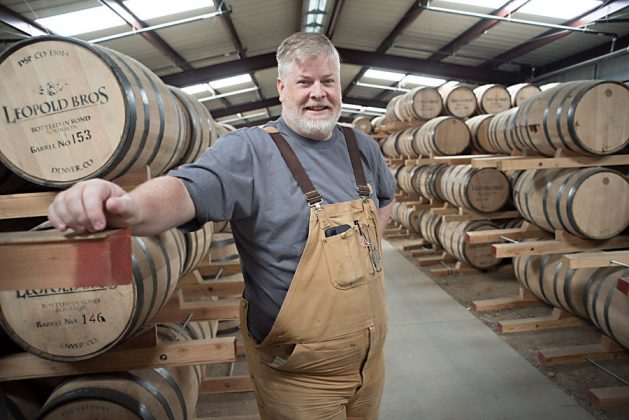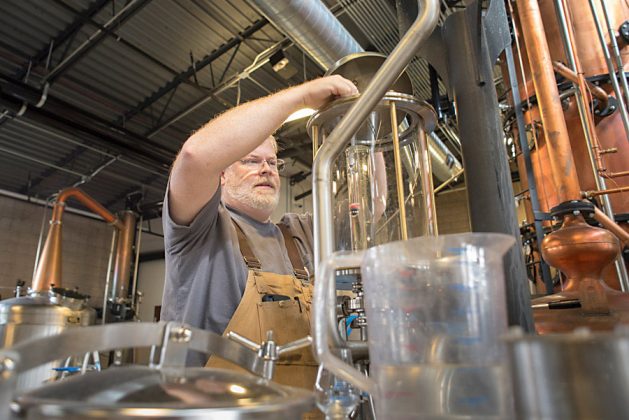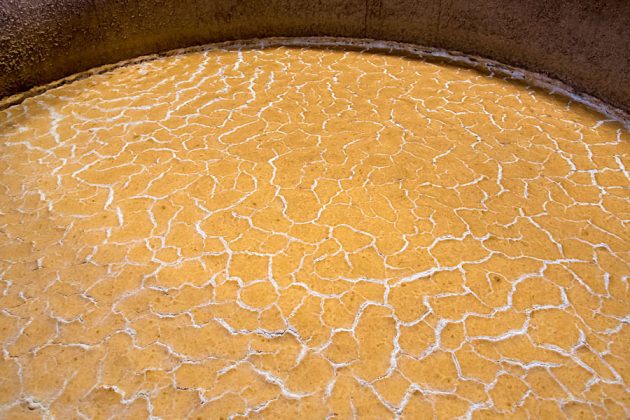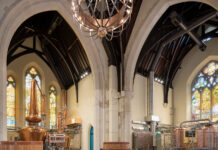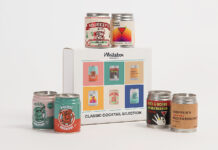The distilling community got a small jolt of reverse innovation when Leopold Bros. began using a once-extinct style of still, based on designs from the late 19th century — when rye whiskey was king.
One of the early spirits the Leopold Bros. distillery produced was Maryland-Style Rye Whiskey. Todd Leopold was curious about Maryland rye. What did it taste like? How was it different from the Monongahela, or Pennsylvania, rye? “This is a lost style of whiskey,” said Leopold. “What a shame to see it go to the trash heap.”
Research into the traditions that gave those ryes their distinctive flavor profiles and blog postings by Chuck Cowdery and David Wondrich pointed Leopold to the chamber still, which was the still of preference for rye whiskey during the time when rye was the preferred whiskey in America. Along with the rye distilleries of Maryland and Pennsylvania, it had not only fallen out of favor, the still fell out of existence. Thought of as an evolutionary link between the earlier pot stills and later Coffey stills, the chamber still had a column that received wash in batches but produced spirit continuously.
In 1898, the IRS commissioned a survey to understand whiskey production methods. They studied 33 distilleries — the mash bills, equipment, barrel management and any detail they could count.
“About half made rye and about half made bourbon,” said Leopold. “They detailed the mash bills, production equipment, entry proof, whether the barrel rooms were heated and everything about the process.” Every one of those distilleries that made bourbon had a column still and every one that made rye had a chamber still. Leopold said the kicker was finding a drawing of the Hiram Walker & Sons plant in Peoria, IL (the largest distillery in the world at the time),which had both Coffey and chamber stills.
“Why would a company like Hiram Walker — which already had a column still, and it is the most efficient way to make whiskey — why would they use the chamber still?” said Leopold. “And the answer was: flavor.”
The chamber still produces heavy-bodied and highly flavored whiskeys. Leopold pieced together designs from historical documents and presented them to Vendome Copper and Brass Works to commission the still.
Leopold’s three-chamber still works thusly: Four kettles, or pots, are placed one above each other in a column. Wash enters a pre-heater/pre-condenser at the top, what essentially would be a fourth chamber but is not part of the distillation path. Three distillation chambers sit below it. The bottom kettle is heated via steam injection. Each successive batch is cooler going up the column because it is farther from the heat source.
Vapors rise from chamber to chamber through inverted J-shaped pipes, which allow vapor to bubble up but do not promote reflux (unlike typical plates that allow vapor to travel up and reflux to drip down). After passing up through the three distillation chambers, vapor exits the top via a worm coil, which spirals through the pre-heater/pre-condenser, and is carried by the lyne arm to a thumper for refining.
Leopold said that, in a column still, wash spends about 90 seconds exposed to steam but cooks for much longer in the chamber still. “The still has three separate chambers where it is exposed to steam. Each chamber runs for about 90 minutes,” said Leopold. “So the wash is cooking 90 minutes as opposed to 90 seconds.”
When the liquid in the bottom pot is spent of useful alcohol, the stillage is drained, making room for the next batch. A valve is opened to allow wash from the next kettle up to pour into the pot below. Each kettle is successively gravity-fed into the next distillation chamber down, and then filled from the one above, until the cycle is complete and the top chamber is charged with fresh wash. Thus the still receives wash in batches and produces spirit continuously.
“What I described is really inefficient, from a cost perspective. It’s a pain in the ass to run, but I love it,” said Leopold, adding how highly flavorful the distillate is. The new-make flowing through Leopold’s spirit safe is so viscous and rich with congeners that it produces a dramatically curved meniscus in the parrot.
In addition to the chamber still, Leopold Bros. also commissioned a Colorado farmer to plant a specialty grain used in the old Maryland ryes. “We have a pretty intensive grain program,” said Leopold. “Starting with a few seeds from a grain bank, we grew the kind of rye that everybody was talking about, which was a strain of Abruzzi rye.”
This particular rye is higher in proteins and lower in starches. Combined with Leopold’s low temperature fermentations, it gives a lower yield of alcohol, about 5%, concentrating more flavor in the distilled spirit. In particular, two components from the Abruzzi rye are 4-vinyl guaiacol, which yields spicy or clove notes, and linalool, which produces lavender and floral notes.
When the alcohol fermentation stalls, Leopold Bros. encourages a secondary fermentation with ambient yeast entering the open, wood fermenters. Landscaping around the distillery is planted with vegetation that promotes specific bacteria Leopold likes for producing acetic acid in the secondary fermentation. The acid creates flavor precursors that give the impression of berries in the resultant whiskey.
“That’s where the secondary fermentation style came from… to chase after that fruit note,” said Leopold.
The whiskey is then entered into barrels at 100 proof, which Leopold said was also common to the distillers in the 1898 IRS report.
“Every single distiller put their whiskey down at 100, all of them,” said Leopold. “Then I started to think: Why are they doing that?”
The lower proof encourages the esterification of wood sugars over tannins. Leopold Bros. uses this entry proof for the Maryland-Style Rye (which is not distilled on the chamber still and already is in wide distribution). Leopold has been laying down barrels from the chamber still for about three years but that whiskey has not yet been released.
“We want it to mature until it matures the way that I want it to mature,” said Leopold, “and that could be two to four more years. I just don’t know.”

